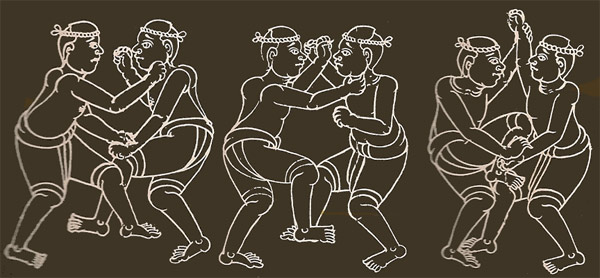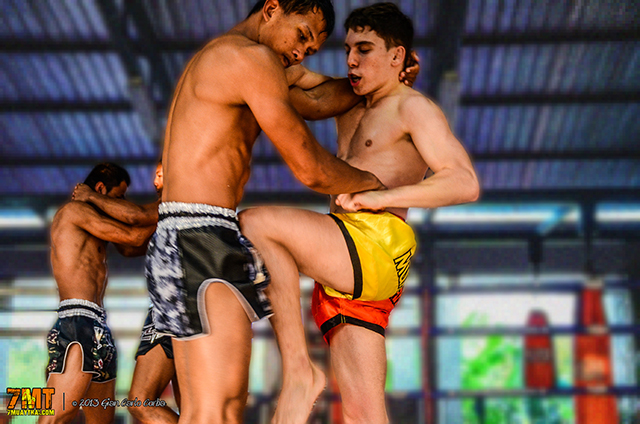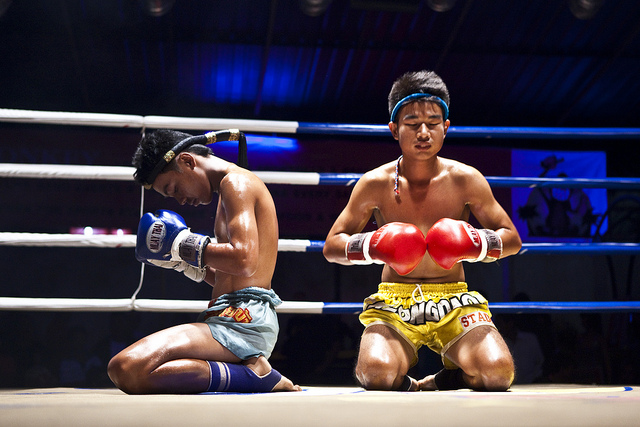The art of 8 limbs.
Muay Thai is a combat sport that finds its origin in a noble art with antique traditions, it is also the Thai national sport. I n Muay Thai, competitors fight standing like in Western Boxing, but elbows, knees and kicks strikes are allowed, with the only protection being the gloves; an important part of this fighting style is the clinch (standing wrestle). MUAY literally means “combat” and it derives from the Sanskrit (original Hindu language) word “Mavya” which literally means “unite together”. While the word THAI is an adjective of the thai nation, its meaning is “free people”. Therefore, the word Muay Thai is translatable as “Thai boxing/combat”. In english the world Muay Thai is generically translated as Thai Boxe. Sadly, this word “Thai Boxe” has created confusion since the Dutch and european in general after them, started to call Thai Boxe their way of fighting Kick Boxing in a Muay Thai oriented way, but which still remains Kick Boxing and cannot be considered Muay Thai, because it can only be when the rules and scoring system are exactly the same as the ones used in the stadiums in Bangkok, mostly Lumpinee. In Western countries, with the definition Muay Thai Full Rules it is intended the official rules used in the big stadiums in Thailand, because, when Western promoters talk about Muay Thai it’s always a question mark on whether it is “real” Muay Thai or Kickboxing “dressed” as Muay Thai. The various fighting styles like: K1, Glory, Fight Code rules or Muay Thai without elbow or limited clinching and others are nothing more than a way to sell Kick Boxing to the audience as it was Muay Thai. Non expert audience often falls in this trap, therefore, we suggest to who wants to see “real” Muay Thai to go to Thailand and, especially, once in a lifetime attend and event at the Mecca of Muay Thai: Lumpinee Stadium. We want to specify that only the greatest Nak Muays (professional Muay Thai fighters) of all times have fought at Lumpinee Stadium and that a one is not Nak Muay unless he hasn’t, at least once, fought and won at Bangkok’s Lumpinee Stadium. The stadium had an historic location, where the greatest Thai and a few Farangs (non Thai) fighters have competed, unfortunately, this will remain the history because this location has been destroyed and replaced by a new modern one. Only who fought at Lumpinee until February 8th 2014 can tell about the epic battles of the “old” Lumpinee Stadium in Rama IV Road near the Lumpini Park and can be proud to have stepped on the same ring as the legends of “real” Muay Thai like: Dieselnoi Chor Thanasukar, Samart Payakaroon, Somrak Kamsing, Saenchai Sor Kingstar, Ramon Dekkers, Kaosai Galaxi ecc.
How it was born:
Muay Thai is the evolution of a natural human habit, so we can also say that it was born with the human kind, because the physical morphology allows mankind to use natural weapons as the arms, legs, head, hands and mouth. The need of defence and natural evolution of practicing how to use of this natural weapons has brought to the birth of training and fighting. In ancient times, tribes merged in actual clans, thats why, confrontation between fighters of different region was inevitable, and each region had a different fighting style just like now days it varies from camp to camp. According to an historic reconstruction there were three main regional styles that influenced modern Muay Thai: Korat, Lopburi and Chaya. Korat style consisted in a low guard but very stable combined with with hard punches and kicks in combination of 2-3 strikes. Ropes (Chuek or Kard Chuek) were used around the hand and forearm to improve defence and to make attacks more efficient. Lopburi was a style based on speed and precision of 4-5 strikes combos. The guard, compared to Korat style, in this style is very high and less stable (main features of the Hanuman style) which compromises the agility. Kard Chueks covered only the hands with some padding on the knuckles (gon noi) and from here origins the modern bandage done before putting the gloves on. Chaya style featured knee, elbow, punch, and kick strikes and continuous lateral movements, step backwards and forward. Even though only those 3 styles are considered, we can talk about another one: Muay Pra Na Korn. This style hails from the fusion of the three previous styles (which happened in the Rattanakosin era, during the accession of the capital that today we know at Bangkok). Strikes could be carried out very quickly or very powerful, the guard could change based on how the fight was going. Kard Chueks would cover completely forearms and hands. This was the time when the first arenas were being built for fighters that became than Muay Thai stadiums. Only after 1925 rules were set and after 1945 also weight categories, rounds, gloves and groin guard (at first made of bark and then changed to a shell rolled up in a cloth and than evolved to the metal one we know today), fights moved from street locations to rings in stadiums. Arenas became real stadiums, amongst the most important we find Rajadamnern Stadium (built between 1941 and 1945 and officially opened August 23th of that year) and the one that is still today the Mecca of Muay Thai, even if not in the historic location as we explained above Link, Lumpinee Boxing Stadium (built after the Second World War and officially opened on December 8th 1956). Mae Mai Muay Thai took the name of Muay Thai in the period in which the Kingdom of Siam changed from an Absolute Monarchy to a Constitutional Monarchy with a Parliamentary System (July 24th 1939) that brought to the birth of the Kingdom of Thailand (“land of free men”). During World War 2 it went back to being called Siam and then, on May 11th 1949, it permanently became Thailand. Only after the Seventies, Muay Thai started to be known and practiced outside thailand and in western countries. The first Europeans to discover it where the French, who at first, brought out a similar fighting style but practiced with special clothes, called Savate.

Real Muay Thai training is sure to be found in Thailand, and the choice of the “camp” is very important. A gym where one lives, eats and trains “real” Muay Thai. For thai fighters, the choice is made based on the area they live as kids and then it evolves into a market just like it is for soccer in western countries (Link). . There are camps in rural areas specialized on bringing up very young Thai Nak Muays to than sell them to big camps in Bangkok to grant them a future in the big stadiums and overseas. Historic camps of Bangkok and of many touristic location in Thailand, at first, did not accept “Farang” (western or non thai) fighters. To fully understand this situation it’s interesting to watch the movie “Chock Dee”. The story told in the movie represents the reality until the Nineties, but then the Thais understood that foreigners were ready to pay well to train in Thai camps and that they would accept to stay in uncomfortable locations; thats how the business of tourists from all over the world coming to try the experience of Muay Thai in Thailand, was born. In the latest years, new traditional camps, are born, with the feature of clean, modern and comfortable structures, so that who would like to try the Muay Thai experience but also wants to stay in a decent room and area and without risking to get some infections, fungus or simply to sleep well at night. Some of this structures are on the beach as well, for example, this new camp in the heart of real Thailand, where Thai culture, crystal clear sea and Muay Thai merge toghter: www.7MuayThai.com Besides training Healthy rest and an appropriate diet, which considered the climatic conditions and the hard training, are fundamental for the athlete, fighter or amateur. A good camp manager doesn’t only have a good Ajarn (Master) who teaches Muay Thai but cares about each aspect of everyday life of an athlete, because Muay Thai becomes an healthy lifestyle of self physical and mental growth. The Arjan needs to take care of the beginners and teach them how to patiently walk to the process of learning and how to overcome the pain that hard training brings. Therefore, he has to manage the training sessions in a gradual way so that the athlete feels at ease and learns the main tools for a Muay Thai fighter: calmness, patience and mainly the fact of living with the small aches caused by any great physical activity. The Arjan sets the training times in the 2 daily session. The first, at sunrise, which starts with the jogging and it ends in the gym and the one in the afternoon, which is the harder one, that ends before sunset. In Thailand, a Nak Muay, besides an athlete, is a symbol of the local culture, where religious spirit and antique tradition of the warrior blend to bring out an ancient 2000 years old tradition. Muay Thai training in western countries Since the year 2000, Muay Thai began to spread all over the world and better understood thanks also to the economic effort of the Thai government that saw its own national sport attacked by the strong influence of football. Training in Europe differs from the one in Thailand in both training styles and intensity and times, often imposed by very different climates. The main feature of the european training is the wide use of punching techniques, this because of the influence of Western Boxing. Western people (“Farang” as called by Thais) sat that Thais wear gloves for no reason since they only train kicks and knees. This is often true, because punches in Muay Thai, for tactical reasons, are less used compared to kicks, elbows and knees. An important reason is the scoring system of Muay Thai that rewards mostly kicks to the midsection and knees, but it’s very complicated to explain. A very well written guide, understandable for the western reader, on how fights are scored in Thailand, is found on the link below: www.MuayFarang.com Muay Thai is certainly one of the most complete and educational sports, that's why it’s becoming very popular in western countries, also just as a fitness and weight loss program. Nowadays, even amongst wealthy Thai people, Muay Thai is adopted as a fitness activity; even if the engine of Muay Thai is still the thousands of Thai fighters that start as kids and then continue doing this sport as their profession to financially support themselves and help their families. Farangs that live in Thailand and that are learning Muay Thai, are now following the path of Thai fighters and teachers and succeed more than ever.

What are them?
Wai Kru is the first phase of the ritual “dance”, during which the Nak Muay walks along the ropes, stopping at every corner and bowing down. This symbolizes a “seal” against bad luck and protection of the fighter during the bout. The fighter, then, moves to the center of the ring and kneels towards his corner, where his trainers and manager are; he then joins the gloves in front of his face, representing the Wai and starts to bow down performing Buddhist prayers. This movement is done three times to greet to the three identities which are on different levels as: Honour of Buddha, Sangha (monks order) and Dharma (Buddha’s teaching); meanwhile, he greets and thanks his Arjan and his camp in general. After the Wai Kru, the Nak Muay proceeds with the Ram Muay which is a slow series of movements, at the typical music rhythm, towards the four sides of the ring, in search of protection. Each athlete performs a specific dance, therefore, most of the time it is different for each fighters. Some fighters use movements that represent their province of birth, while others simply add personal moves. With time, Ram Muay and Wai Kru became an added show for the audience of “real” Muay Thai lovers. This “dance” is mostly a moment for the fighter to find mental concentration. In the big stadiums of Bangkok it’s mandatory to perform the Wai Kru, as its to use of the Mongkon and Pra Jiat -Read more Not all fighters wear these amulets and perform the Wai Kru, in fact, Ramon Dekkers did not wear the Mongkon and Pra Jiat and did not perform any ritual dance.
